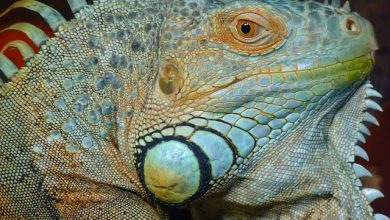Cleaning Your Reptile’s Cage – The Tye-Dyed Iguana

The horror! Itâs that time againâtime to clean your reptileâs cage. Itâs funky. Itâs full of habitat décor, and your exotic pet is not too happy about being temporarily removed from its home. But despite all those obstacles, cleaning your reptileâs cage is essential to your herpâs long-term health. The Tye-Dyed Iguana has you covered with tips for making this dreaded task go as smoothly as possible.
Getting down and dirtyâthe deep clean
Thereâs no exact consensus on how often you need to do a thorough deep cleaning of your reptile cages. If you have multiple cages, you may want to put them on a rotation and deep clean one each week. If you just have one exotic pet (or you have multiple and prefer to clean all the cages on one day) then you should probably do a deep clean about once every one to three months. The time frame really can vary depending upon the type of reptile you own and how unpleasant the smell of their cage gets.
To clean your reptileâs cage, you will need to remove the animal and place it in a temporary cage for the duration of the cleaning, just like you do when you quarantine a new specimen. Itâs a good idea to have this alternate location set up well before cleaning time. You can also let them have a bit of free roam time in a safe space.
Now itâs time to remove all the decorations and the food and water dishes. Go ahead and wash the dishes while theyâre out. You should actually be washing your exotic petâs dishes at least once a week, not just during a deep cleaning. Otherwise, parasites can take root in wet or soiled dishes.
Youâll also need to scoop out all the substrate, fecal matter, and other organic matter in the cage and replace it with fresh substrate after scrubbing out the cage. You can use a simple mild dish soap for cleaning, or a reptile-safe cleaning agent, and make sure that you rinse thoroughly because soap and chemical residues are not good for your herp. To disinfect, you can use diluted bleach, but a safer alternative is to spray the cage with white vinegar and wipe it out.
After everything is clean, rinsed, disinfected, and dried, you can add the fresh substrate and start moving your dishes and décor back into the terrarium.
Daily cleaning tips for an easier life with reptiles
To make the big cleaning day a bit easier (and to keep down odors and promote a healthy reptile environment), you can make a routine of doing a few daily chores. Go ahead and scoop out feces and spills once per day so they donât build up or harden into stuck-on residue. You should also take out uneaten food and any shed skin in the cage. Youâll be thankful you did this when you get to the deep clean and donât have to scrape off disgusting residue bits from the bottom of the cage.
Come by The Tye-Dyed Iguana and ask us how we clean our array of reptile and amphibian cages for more tips.



